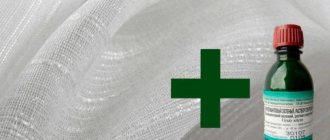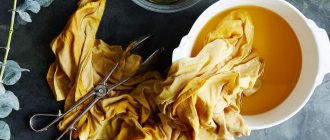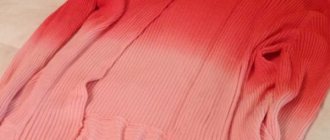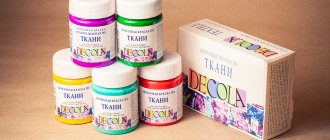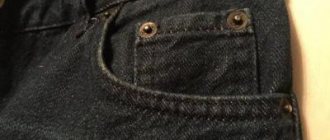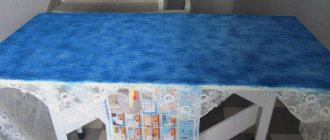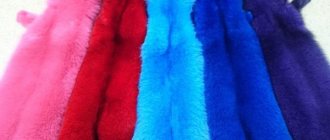Pigment selection
What natural dye can be used to dye fabric:
- tea;
- cocoa - for a chocolate shade;
- rich coffee will turn black;
- onion peel;
- wolf berries - red;
- blueberries, blackberries for a juicy purple color;
- cranberry;
- walnut peel - beige or sandy;
- spinach, sorrel, elderberry leaves will color the canvas green;
- beets for the pink to burgundy range;
- cabbage;
- turmeric, celandine – orange, red;
- carrot juice, sea buckthorn.
On a note
Tip: to consolidate the results of using natural pigments, use vinegar essence and salt.
How you can dye things: stores sell a special fabric dye in the form of a liquid, paste, spray or powder. The main advantage of such a tool is that there are clear instructions, it’s difficult to make a mistake. Some people use food coloring.
Is it possible to dye fabric with hair dye: yes, but the color may not be very saturated. Especially if you use dark shades on heavily faded material. If you are not careful, the material will become stained.
Natural fibers are painted with acrylic paints. It is not possible to fill artificial or synthetic organza with pigment using acrylic paints.
White fabric dye comes in acrylic, aniline, or spray form. It is applied to pre-bleached fabric to give a pure shade.
Preparation
Preparing to paint things at home:
- You will need a clean canvas. It is thoroughly washed and rinsed. There should be no detergent left. It will react with the dye, the result will be unpredictable.
- Before washing and subsequent dyeing of the fabric, stains must be removed. With them the color will be uneven. A non-aggressive stain remover is needed.
- For intensity, the material is boiled for 10 minutes or bleached before the process.
- It is necessary to remove all unnecessary objects: buttons, snaps, and remove the metal lock. Painting the fabric will ruin them and may cause rust in the future.
- What paint can be used to paint different colors of materials? Light and white clothes lend themselves to all shades. Colored - only dark, but can be pre-bleached. How to dye fabric at home? Black products will first have to be bleached for a long time, this can damage the structure of the fibers. To turn a black item made from natural fibers into a gray color, it is enough to boil it several times with an aggressive powder. You can add just a little bleach.
- Natural fabric is easy to paint. It's easy to dye cotton, wool or linen at home. They quickly absorb paint and do not fade. Finished synthetic products are almost not painted. Chemical fibers are colored at the initial stages of production. You will need special paint for synthetics.
- A new linen or cotton item is saturated with starch. Before dyeing clothes, it must be removed. Make a solution of soap and soda and boil for twenty minutes. Then rinse to remove all excess substances.
- Wool yarn is rolled into skeins and tied with rope in several places. It shouldn't get tangled in the process. For convenient turning over, the skeins are strung on a rope.
- Fabric dyeing is done in distilled water. Tap water is softened by adding a teaspoon of soda per ten liters.
The amount of dye depends on the weight of the product. How to paint things with paint is described below.
Inventory preparation
To paint things you will need:
- Enameled or glass fireproof container. There should be no chipped pieces. Before using aluminum or galvanized basins, scale must be removed from them.
- The size of the dish should allow the product to float freely without creasing. Fabric dye will not absorb evenly.
- To mix the paint and turn things over, you will need two wooden sticks. They are pre-cleaned of knots/irregularities.
- Scales or measuring cup/spoon and paper towels are required.
Important: work is carried out with rubber gloves. The dye will damage delicate skin or will not wash off for several days.
General recommendations
Tips on how to dye clothes at home:
- if there are several products, they are painted one by one;
- wool product is diluted at high temperature;
- before dyeing flax and denim, the paint is mixed with a pinch of calcined salt, then dissolved with water;
- unevenly dyed viscose is placed briefly in a hot solution of washing powder - the color will become even;
- It is recommended to dye silk by adding a tablespoon of vinegar;
- the product that will be altered is ripped out before painting;
- to avoid burning, place a board at the bottom of the container;
- It is not difficult to dye a faded item; it absorbs the dye easily;
- Woolen clothes are dried flat out to prevent them from stretching.
Synthetic products should not be dyed yourself. Where to dye the fabric: you need to take the item to the dry cleaner. Professionals will do this evenly and correctly.
Useful
Interesting: you can mark a thing with ink, for example, when sending a child to camp. It will be impossible to iron the painted area and erase the mark.
Features of painting items made of woolen fabric
If you need to dye not a skein of yarn, but a whole woolen item, you should follow some precautions. Painting a whole canvas is a little more difficult, but it is quite doable. The painting procedure is no different from that described above: you also need to soak the product in a decoction or dye solution. It is advisable to lay the item so that all folds are free. This way the solution will evenly saturate all areas .
The painted product should be dried in a horizontal position and straightened out to avoid any possible smudges. How to remove a ring using thread? What should a woman 50+ have in her wardrobe?
Dyeing different materials
In order not to make a mistake with the choice of dye and method, it is worth learning how to dye fabric at home.
Cotton
It fades quickly and fades. You will need durable cotton dye and soft water, melt or rain. How to dye cotton fabric:
- store-bought product is diluted in accordance with the specified proportions;
- the composition is heated to 50 degrees, the item is poured;
- cook for 20 minutes, add calcined salt;
- continue cooking for 35 minutes;
- take out and rinse with warm water.
At the end, the cotton fabric is rinsed at a cool temperature with the addition of a 5 liter spoon of vinegar.
How to dye a cotton jacket: the principle is the same, but add a few tablespoons of salt after boiling. This is necessary to reduce shedding.
Linen
Fabric paint, how to use with flax fibers:
- throw the pigment into the water and mix;
- place the item and cook for half an hour with the addition of a spoonful of salt;
- the finished product is rinsed with cold water and vinegar;
- it is wrung out and laid out on a towel.
Tip: if you need the fabric urgently, you can iron it after 35 minutes.
How to dye wool
How to dye: Aniline dye is best.
How to dye a woolen item at home:
- one sachet is dissolved in 0.5 liters of water;
- add warm water to the composition;
- place the product in the container and wait until it boils;
- after 25 minutes, add 75 ml of acetic acid.
How to dye fabric brown: boil it in onion peels at the rate of 400 g of peel per 100 wool. Rinse in the same way.
The finished clothes are placed over the bathtub/basin and left so that the bulk of the dyeing liquid is glassed off. Then rinse with cold water. The last rinse is accompanied by lemon juice.
How to dye cashmere: the rules are the same, but use a special dye marked “for wool.” However, it is better to take such a delicate item to the dry cleaner.
Silk
Dyeing of silk products:
- wash new material in case it is soaked in something;
- dilute the dye slowly with water, adding a little liquid to form a thick paste;
- pour the product into 0.5 liters of water, stir and strain through a clean cloth;
- dilute according to instructions;
- to dye a silk skirt or dress faster, add a spoonful of salt per liter;
- the composition is boiled, the heat is reduced and the clothes are placed;
- after 30-40 minutes, turn off the stove and leave the item in the pan for half an hour.
Freshly dyed fabric is washed at a hot temperature many times, and finally at a cold temperature.
Synthetics
How to dye synthetic fabric:
- dilute 20 ml of formic acid 85% in 10 liters of water;
- the dye is dissolved in the composition;
- stir thoroughly and place the synthetic product;
- cook at a temperature of 40-45 degrees, no more;
- After half an hour, rinse with cold water.
You need to know not only how to paint synthetics. The finished item will have to be washed separately at least three times, it will fade noticeably.
The dye for tulle should be durable and bright. This polyester material does not absorb pigment easily. Tulle can be starched for dye fastness.
Polyester
How to dye polyester:
- soak clothes with washing powder for half an hour at temperatures up to 40 degrees;
- rinse with the addition of ammonia;
- use only a special dye for polyester, diluted strictly according to the instructions;
- the time and method indicated on the packaging differ from one manufacturer to another.
In order not to spoil a synthetic item, you must completely follow the instructions and not use natural dyes. Faded fabric made from polyester fibers is easier to dye.
Viscose
How to dye viscose at home:
- combine the dye and calcined salt;
- paint for artificial fabric is the same as for natural fabric;
- dilute in hot water;
- put half of the liquid into a pan, place viscose material;
- slowly bring to a boil, add a little salt;
- after a quarter of an hour, they take out the item, pour the second half of the dye into the dish;
- How to dye viscose fabric further: boil for 20-30 minutes.
An unevenly colored item is rinsed in a powder solution, then in clean water.
Coloring of products
The type of clothing dye you use at home depends on the item.
Painting a T-shirt with gouache:
- combine PVA glue and gouache in half;
- apply a design to the material with a brush;
- When changing colors, thoroughly wipe the brush;
- For a three-dimensional pattern, press lightly; for a flat pattern, press in.
Gouache or watercolor are ideal paints for cotton at home. If you don't like the product, it's easy to wash it.
How to dye corduroy pants:
- use purchased dye according to the instructions;
- fix the result with a vinegar solution at the rate of 1 spoon per 5 liters.
1Velvet is a dense and durable material, but delicate. It should not be dyed or machine washed. 2How to dye a cotton shirt: like any other cotton item. In soft water, fixing the result with vinegar solution. 3How to paint a synthetic dress: use disperse paint. Other dyes will not be absorbed, will run off, and streaks may remain. 4Is it possible to dye a chiffon dress? It is better to take such a delicate item to the dry cleaner for painting. A chiffon blouse should also be protected from independent experiments. 5A white dress made of natural material can be colored with any pigment. You can try natural dyes. Blueberries and blackberries will help color them blue or deep purple. Folk remedies can easily dye thin fabrics made from natural fibers.
How to dye a towel at home:
- dilute permanent paint according to instructions;
- pour 10 liters of water and boil;
- Throw a towel into boiling water and cook for an hour until the fabric turns a different color;
- rinse thoroughly several times in warm and cold water;
- fix the result with vinegar.
It's easy to dye the fabric a different color if the desired color is darker or brighter than the previous one.
It is better to paint jeans or other natural materials blue. It is not persistent, but does not spoil the structure of the fibers.
How to dye a shirt: a review of natural dyes
In addition to artificial dyes, you can also use natural ones. Juices from vegetables and berries are suitable for this. This coloring looks very interesting and unusual. True, natural dyes do not give such lasting results. It is quite difficult to predict the color that will turn out.
List of natural dyes:
- Onion peel
- Coffee
- Tea
- Vegetable, berry and fruit juices
- nettle leaves
- Turmeric
- Orange or lemon zest
- Buckwheat leaves
- Tansy
- Oak bark
- Spruce cones
Textile dyes
Before dyeing, it is advisable to try the dye on a piece of fabric. Don't dye clothes you're sorry for.
Other fabric dyeing options
How to paint a tarpaulin black: construction paint. It will take a long time to dry. Rubber paint is also suitable for tarpaulin fabric.
How to paint canvas fabric with rubber paint:
- apply a thin layer to the surface;
- leave to dry according to instructions.
Under the influence of such a dye, tarpaulins of any shade can be painted even white.
Painting gauze in different colors:
- the material absorbs almost any dye;
- You can use the juice of berries and fruits, a decoction of herbs.
How to dye fabric with tea at home:
- Brew tea to the required intensity depending on the desired color;
- put the product in it and leave for 30-40 minutes.
The method is suitable for natural fibers.
Knitwear does not require special dye. You need to know the composition of the fibers, that’s enough. The only rule is not to boil or cook in very hot water, so that the knitwear does not stretch.
How to dye a stain on clothes:
- Use a colored marker to paint over the problem area;
- Apply a clean cloth and iron from the inside out.
The paint for black fabric should be saturated. Black fabric paint, how to paint:
- dilute 1 package per 0.5 l;
- pour warm water over the mixture and place on the stove;
- when the liquid reaches 50 degrees, place the item there;
- after boiling, remove the product;
- add 2 liters of saline solution to the pan;
- place the product again and leave for 35 minutes, let it boil a little;
- After that, remove from the stove and leave for another half hour.
Rinse the finished item under warm temperature. Black lace is dyed in the same way, but the exposure time is reduced by 1/3.
You can paint tulle with improvised means: brilliant green, potassium permanganate, blue. Onion and nut peels, berry and vegetable juice, tea, coffee are suitable.
How to dye burlap at home:
- burlap is not completely dyed;
- put water-based emulsion on the brush and apply it with shock movements;
- A spray is suitable; it is simply sprayed at a distance of 20-30 cm.
Raincoat fabric is painted with nylon paint at temperatures up to 50 degrees, so as not to damage the structure.
Rubberized fabric is painted in the following way:
- combine rubber glue and construction color in half;
- apply to the product with a brush;
- leave until dry.
Sintepon can be easily painted with auto enamel spray.
If desired, any fabric can be dyed, but it is better to dry clean delicate and synthetic items.
© 2021 textiletrend.ru
How to dye fabric white. The process of dyeing tulle and white T-shirts
Preparing fabrics for dyeing is a prerequisite when choosing any of the various dyes. By dyeing only clean fabric, you can achieve the desired result. Be sure to wait until the fabric is completely dry after washing; slightly damp tulle or a T-shirt will quickly absorb all the coloring pigments.
Important! The color intensity of a fabric product depends on how concentrated the dye is, as well as on time. Therefore, think about how bright the result you are trying to achieve before dyeing the fabric with green paint.
Aniline dyes
If you choose this method of coloring, do not experiment under any circumstances. You can effectively paint tulle in a different shade only by strictly following the instructions. The following options are possible:
- Dilute the dye in a small container until the dye is completely dissolved, and then pour it into the main volume of water, and then place the tulle there.
- Immediately add the dye to the basin or to another container into which you have already poured warm water. Place the item you are painting into the resulting solution.
Important! Quite often, dye manufacturers advise salting water with table salt to obtain a permanent color. The proportions of salt, water, and dye must be indicated in the instructions.
Good old green stuff
Painting the fabric with green should be done by those housewives who want to see window curtains or T-shirts in a greenish tint. The method of application is extremely simple:
- Dissolve a small amount of green pharmacy liquid in warm water. Determine the required volume of medical solution yourself, based on the desired brightness of the final shade. On average, about 10 ml of diamond solution (1 bottle) is taken per 5 liters of water.
- Stir the entire contents of the container evenly.
- After this, place a damp cloth or T-shirt there.
- Let stand for 20-30 minutes.
Important! You can paint clothes with green paint evenly at home, without streaks or stains, only if you periodically turn the product over in the container. The same rule applies when you decide to change the shade of tulle, curtains, nylon mesh or any other textile.
Fukortsin
You need to dye your clothes with green paint if you want to get a green color. Everything is logical here. And if you want to give the fabric a soft pink tint, then feel free to take a similar medical solution called “Fukortsin”. It is popularly called “pink green”, since it is similar in its properties, but has a distinctive color.
The entire painting procedure takes a very short amount of time, and the result will definitely please you. The principle of coloring is exactly the same as when using brilliant green.
Important! If you have powdered potassium permanganate in your home stash, it is an excellent analogue of “Fukortsin” for dyeing fabric. Feel free to use it.
Fragrant coffee and tea
In order to give your window curtains a beige or cream shade, you can use tea leaves or ground coffee. Dyeing fabric with tea at home is just as easy as with other natural dyes - 2 tsp. tea leaves or coffee is enough to prepare a coloring solution:
- Place 2 tsp in 1 liter of boiling water. tea leaves or ground coffee.
- Wait until completely dissolved and then strain.
- After this, place the fabric item to be dyed into the decoction you have prepared.
Important! If the tulle is too large, then increase the proportions of tea or coffee and water.
Beetroot - natural dye
This product has excellent coloring properties and is also capable of dyeing curtains and T-shirts in a different color.
To dye tulle at home:
- Cut the beets and fill them with alcohol or vodka in the proportion of one bottle per 1 kg of beets.
- Cook the beets until completely softened with the lid closed.
- Strain the juice, and dip your product into this strained juice.
- The time to “bath the fabric” depends on how saturated you want the shade to be.

